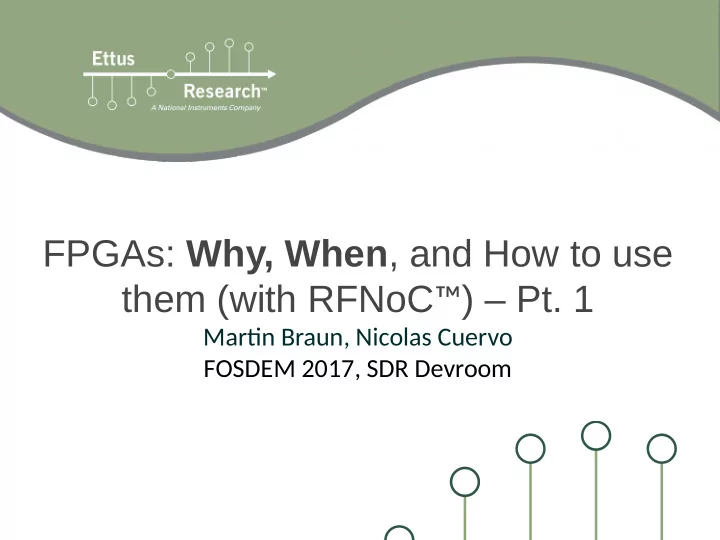

FPGAs: Why, When , and How to use them (with RFNoC ™ ) – Pt. 1 Martjn Braun, Nicolas Cuervo FOSDEM 2017, SDR Devroom
Schematjc of a typical SDR Very rough schematjc: Analog ADC/DAC FPGA GPP Stuff Let’s ignore the analog stuf FPGA sits closest to the ADC/DAC GPP is separated by some transport (USB, Ethernet, DMA FIFO, or maybe it’s just on the same PCB)
What is an FPGA? Wikipedia: ‘an integrated circuit designed to be confjgured by a customer or a designer afuer manufacturing – hence "fjeld- programmable"’ In SDRs: Efectjvely a user-defjnable digital circuit between ADC/DAC and the sofuware Can be redefjned “any tjme”, but will take down the circuitry while doing so Typical clock rates: several hundred MHz (or more? Or less?) Remember these:
How are FPGAs programmed? 1. Defjne your circuitry (shall it fjlter? Shall it generate UDP packets? Shall it...) 2. Encode that in a format your FPGA toolchain understands (Verilog, VHDL, graphical tools) 3. Synthesize to netlist + generate bitstream. A bitstream is a binary representatjon of how the internals of the FPGA is confjgured. Ofuen proprietary formats. 4. Load bitstream onto FPGA, typically using dedicated pins.
What do we use FPGAs for? Can an FPGA run sofuware? Well, it can, but only if you make it look like a CPU. Let’s ignore that for now. If you can draw a digital circuit, it’ll usually work well on an FPGA Multjple parallel circuits are also possible, and in fact one of the strengths of FPGAs. Latency can be controlled on the order of clock cycles. These work well: – FIR fjlters, FFTs, Neural Networks – Control loops These not so much: – Protocol handling, complex rulesets (Source: htups://github.com/Themaister/muFFT/blob/master/doxygen/ffu.md)
Flexibility (or lack thereof) During “runtjme”, the digital circuit can’t be easily replaced Building bitgiles can take a long tjme (depending on the tools, design, and chip between a few seconds and several hours) If your FPGA is controlling peripherals, those will be disabled while the FPGA is reprogrammed (Source: Etuus Research USRP E310 Schematjc fjles.etuus.com/schematjcs/e310)
Challenges: Digital Logic Did you pay atuentjon in school? Quick, what’s this equatjon as a digital circuit: Concepts may seem trivial if you’re an EE major, but there’s a lot of concepts worth knowing (Types of fmip fmops, bus arbitratjon, interface designs, memory architectures, …) What does this do? (Source: htups://en.wikipedia.org/wiki/Shifu_register)
Challenges: Circuit Magic The digital logic is only half of it What kind of constraints are relevant for our SIPO? Where did the clock come from? How fast is it? Will the FFs keep up? How long do I need to read the outputs? Is ‘Data In’ a pin? Are QN pins? Shouldn’t I connect reset lines?
Challenges: Tools Most likely, you’re leaving the safe, easy confjnes of running gcc and clang You’re in for a treat! Good luck gettjng Vivado running on Gentoo. Ever heard of TCL?
Pointers EDA Playground: Play around with Verilog in your browser Yosys, Icoboard: RPi, free sofuware Xilinx, Altera have eval kits e.g. from Digilent USRPs will let you do SDR
ToC RF-Network-on-Chip ( ) RFNoC
If you only remember one slide… RFNoC is for FPGAs is what GNU Radio (currently) is for GPPs. RFNoC GNU Radio Provides Easy-to-use Infrastructure for SDR applications Handles Data Movement between blocks (AXI-Based) (Circular Buffers) Takes care of boring and recurring tasks (Flow control, (R/W pointer up- addressing, dating, tag routing) handling…) Provides library of blocks to get started (Growing) (Huge and well- tested) Works with GNU Radio Companion (Through gr-ettus) (Built-in) Well-documented (Right?) (Right? RIGHT?) Writes your blocks for you
Example: Wideband Spectral Analysis ▪ Simple in Theory: 200 MHz real-tjme, Welch's Algorithm ▪ In practjce: Several stumbling blocks. That’s the problem RFNoC is trying to solve. FPGA: Highly parallelizable operations, basic math Underutilized => Ideal to shift to FPGA Transport: Overloaded
Example: E310 + fosphor ▪ RFNoC + GNU Radio: Work nicely together ▪ Ideal way to use and test RFNoC is with GNU Radio ▪ Data is passed between "domains" easily RFNoC Messages Domain Crossing GNU Radio
RFNoC Architecture User Applicatjon – GNU Radio HOST PC USRP Hardware Driver Ingress Egress Interface USRP FPGA Crossbar Computatjon Computatjon Radio Core Engine Engine
Device Confjguratjon To Other RFNoC Capable Device Crossbar Radio Core FFT FIR Demodulator Compression Sofu Processor Crypto Core Decompression MicroBlaze ▪ Blocks are chosen when bitgile is generated
Anatomy of an RFNoC Block To Host PC Crossbar Radio Core FFT Depacketjzer Packetjzer Depacketjzer Packetjzer FIFO FIFO FIFO FIFO AXI-Stream TX DSP RX DSP Your IP RX Sample Data ▪ Blocks are separate entjtjes ▪ Separate clock domain ▪ Optjmized for developing separately
Recommend
More recommend